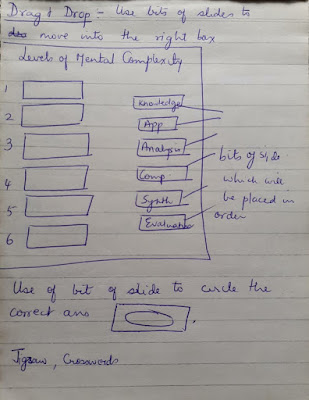Progressive Disclosure Comes of Age
 |
| From Pixabay - an advertisement |
[The credit for this memory-jog is from my friend and former colleague, partner in crime in Hyderabad, Padma. She sent me the snapshots which feature in the main text below and got me thinking of how we, as trainers and facilitators, metamorphosed from the humble chalk-and-talk to the various kinds of projection equipment that we used across all our training. Thank you Padma. Please Comment and Share this blog.]
Mystery Words
I mentioned the term "Progressive Disclosure" to a young 20-something and she blushed, flustered. When I asked what she was thinking, she hesitantly muttered, "Is that like strip-tease?" Knowingly, I tried another word - "OHP". This time she was truly mystified. "What's that? A kind of complex -- like OCD?" Aha! I was making her think. Then I popped the next word into a sentence. "No, it's what came after the good, old charts and pictures. The OHP was replaced by the Carousel!" Now she was vacillating between calling the cops on this dirty old man or taking the plunge into that depth of knowledge that was just beyond the next bend. "What comes after Carousel?" she asked tentatively. Now, I had her. "Why, the LCD", I exclaimed triumphantly. Suddenly all was as clear as daylight. "LCD, of course!", she cried, whipping out her mobile phone. "It's what keeps breaking every time you drop your mobile, isn't it?" I retired into my memories, temporarily defeated, till Padma got me thinking.
Transparency - that's the key
I'm not that bad. I didn't use the word transparency in that context, but I was reminded how we created a whole new world in classroom training in the days of Overhead Projectors (OHP, in case you're still lost). There's an image of one below.

Manual Animation
What happens at the click of a mouse or a Presentation pointer (or slide advancer) today and is flamboyantly called "custom animation" was a clever little trick that we OHP-ers used. The prepared slide was laid over by a sheet of paper and carefully dragged down or across to reveal the slide in bits - progressive disclosure. The trick came undone when, in our non-airconditioned halls, the swivel fan sometimes blew the covers off the slide leaving it over-exposed though the lesson was under-developed. Like a bad photograph.
Other forms of manual animation referred more to the presenter who had accidentally shuffled the order of his slides. You couldn't imagine a more animated lecturer whose slides were in the wrong order. This could happen with PPT too, except that getting them back in order would be far more difficult that the OHP. It also kept the lecture shorter.
Tricks of the Trade

Layering was also unbeatable when a teacher wanted to actually draw on a slide, like she would do on a board, without marking the original slide. All she did was to lay a blank slide over the original and draw to her heart's content. This is something that has been mimicked by electronic whiteboards and drawing tools, but the pen is mightier than the mouse any day, as any teacher will tell you.
All this made all our slides highly reusable - a formula still followed today with PPT and its clones.
 Collaborative Learning
Collaborative Learning
This wasn't just a buzz word but a reality back in the day. I recall giving one blank slide to each group of students, along with a pen, and asking them to write out the points of discussion for a class debate. We did this with groups of young programmers learning to code as well. Then each group came up and presented their slides on the OHP. Not difficult to replicate today, if each group has a computer and can share their slide on a network. But so easy to do in a classroom with one OHP.
Drag and Drop and Column Matching were other techniques which could be easily used with OHP slides. The former is still a mammoth task with PPT and I am not sure that column matching can be replicated on a computer except with custom-animated arrows!
I have even used bits of transparencies to teach number sequences to primary kids!
Back to the Future
So, by now you must think that I am recommending a shift back to the good old days, right? Wrong! While I extol the virtues of the OHP and have used it in multiple ways, I have happily adopted the LCD-and-Computer combo for most presentations today. Yes, there are times when it drives me up the wall, literally. As you can see in the cover picture, some LCDs are mounted on ceilings and one had to get up there to adjust the focus or fiddle with the settings. The worst are the conference rooms where your laptop has to be on a podium, because that's where the wires are and you are also expected to be. And this is not against PowerPoint either since I have used it as an example all over -- I'm a Google Slides man myself, but same category, same pros and cons. Though some of the slides I have seen make me wonder, "What's the point if there is no power in it?" That goes for electrical power points too.
My three learnings from the story above:
- there is much to be learnt from the technology we have left behind
- the power is not in the hardware but in the ingenuity of the teacher
- progressive disclosure is in the technique, not in the software



Les, just so good... Love your style and how you make it so hilarious and an enjoyable read. Loved and agree with the learnings as well.. You are a storehouse of talent!
ReplyDeleteThanks Padma, my partner in crime and training!
DeleteLeslie that was such a lovely trip down the memory lane. Always a pleasure to read your work. Yes the power of a teacher needs to be acknowledged. I feel pity when I see the ads of online learning.
ReplyDeleteMeenu, we've worked together on some other unusual projects. Share some memories, maybe I'll write it up from my POV. BTW, you should join my WA group (it's one way, so less noise). Will send the link
DeleteHahaha...thoroughly enjoyable, brought back memories of old days of tech in classrooms, the agonies of dysfunctional sockets, looking for anyone over 6'to reach the buttons of the overhead LCD projector - all so vividly captured, thank you..and i will surely put progressive disclosure to good use (in discomfiting the staid :))
ReplyDeleteThanks for the feedback. Why are you unknown? Would love to know who you are.
DeleteAnd then there's another visual aid that never fades away: body language.
ReplyDeleteAs you know so well, Sumit. And as you use so effectively in the Red Curtain plays online
Delete